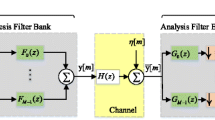Abstract
The direct conversion receiver is attractive for being able to provide low-cost and compact receiver design for wireless communications. However, the oscillator imbalance in the in-phase and quadrature components of its mixing sinusoid introduces additional self-image interference, which is a non-linear effect to the received signal. Relying on just one OFDM training symbol, we formulate the joint estimation of oscillator imbalance, DC offset, and channel response as a linear model. A low-complexity least squares (LS) estimation method is then proposed. The transformation matrix in our model is shown to be of full rank with probability 1, which allows our LS approach to be realizable for a variety of training OFDM symbols. Justified by simulation results, our method outperforms the other three LS methods in the literature.






Similar content being viewed by others
References
Razavi, B. (1997). Design considerations for direct-conversion receivers. IEEE Transactions on Circuits and Systems, 44(6), 428–435.
Tseng, H. Y. , Cho, W. J., Chang, T. K., Phoong, S. M., & Lin, Y. P. (2008). Compensation of IQ imbalance and DC offset for OFDM transmission over frequency selective channels. In Proceedings of international conference on communication (ICC) (pp. 641–645).
Sohn, I. H., Jeong, E. R., & Lee, Y. H. (2002). Data-aided approach to IQ mismatch and DC offset compensation in communication receivers. IEEE Communications Letters, 6(12), 547–549.
Sung, K. Y., & Chao, C. C. (2009). Estimation and compensation of I/Q imbalance in OFDM directconversion receivers. IEEE Journal of Selected Topics in Signal Processing, 3(3), 438–453.
Shiu, M.-S., & Liu, T.-H. (2013). Practical signal recovery of WLAN OFDM signals in the presence of IQ imbalance, phase noise, and unknown channel frequency response. Wireless Personal Communications, 68(3), 779–788.
Morelli , M., & Moretti, M. (2010). Frequency offset estimation in I/Q mismatched OFDM receivers. In Proceedings of IEEE Global Telecommunications Conference.
Lin, H., Zhu, X., & Yamashita, K. (2010). Low-complexity pilot-aided compensatonfor carrier frequency offset and I/Q imbalance. IEEE Transactions on Communications, 58(2), 448–452.
Hsu, C. J., Cheng, R., & Sheen, W. H. (2009). Joint least squares estimation of frequency, DC offset, I-Q imbalance, and channel in MIMO receivers. IEEE Transactions on Vehicular Technology, 58(5), 2201–2213.
Xing, G., Shen, M., & Liu, H. (2005). Frequency offset and I/Q imbalance compensation for direc-conversion receivers. IEEE Transactions on Wireless Communications, 4(2), 673–680.
Heiskala, J., & Terry, J. (2002). OFDM wireless LANs: A theoretical and practical guide. Indianapolis: Sams Publishing.
IEEE Std 802.11a, Part 11: Wireless LAN Medium Access Control (MAC) and Physical Layer (PHY) specifications: Amendment 1 High-speed Physical Layer in the 5 GHz Band, (1999).
Coleri, S., Ergen, M., Puri, A., & Bahai, A. (2002). Channel estimation techniques based on pilot arrangement in OFDM systems. IEEE Transactions on Broadcasting, 48(3), 223–229.
Gil, G. T. (2008). Nondata-aided I/Q mismatch and DC offset compensation for direct-conversion receivers. IEEE Transactions on Signal Processing, 56(7), 2662–2668.
Kay, S. (1993). Fundamental of statistical signal processing: Estimation theory. Englewood Cliffs: Prentice-Hall.
Oppenheim, A., & Schafer, R. (1999). Discrete-time signal processing (2nd ed.). Englewood Cliffs: Prentice-Hall.
Tse, D., & Viswanath, P. (2005). Fundamentals of wireless communications. Englewood Cliffs: Prentice-Hall.
Author information
Authors and Affiliations
Corresponding author
Rights and permissions
About this article
Cite this article
Chou, CP., Liu, TH. & Wu, CH. Robust Training Symbol Assisted Least Squares Estimation for Direct Conversion Receivers with Oscillator IQ-Imbalance. Wireless Pers Commun 95, 1397–1406 (2017). https://doi.org/10.1007/s11277-016-3853-0
Published:
Issue Date:
DOI: https://doi.org/10.1007/s11277-016-3853-0




